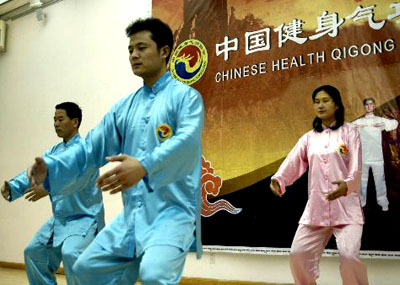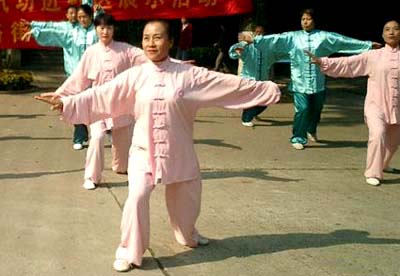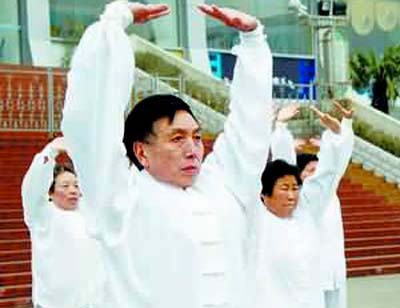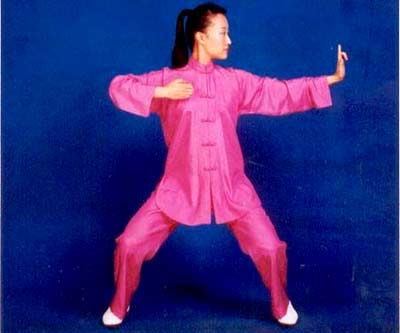Qigong, known as an important component of traditional Chinese culture, originated in ancient China and its functions vary among different traditional Chinese cultural schools. (Click to watch the introduction video of Qigong  )
)
Confucians practice Qigong to cultivate their mind and body; Taoists and Buddhists do it to transcend worldliness; Chinese medical physicians use it to cure illness and maintain health; and martial arts learners practice it to defend themselves and ward off attacks.
A group of Qigong masters have paid a 14-day visit to the United States from January 30. This is the first time the ancient Chinese healing practice has been formally introduced to Americans.
A group of Qigong masters have paid a 14-day visit to the United States from January 30. This is the first time the ancient Chinese healing practice has been formally introduced to Americans. During China's Spring Festival period, the Chinese Health Qigong Association has also sent another five groups to six countries to promote healthy Qigong. A total of 36 promotion events are planned for 2008.
Since 2006, the association has held three rounds of overseas promotion tours, reaching more than 50,000 people in nearly 30 countries, and over 10,000 have begun to practice health qigong. It has also deployed trainers in 29 countries.
At the beginning of the new century, the Chinese Health Qigong Association developed four Health Qigong Exercises based on superior traditional Qigong practices, including Wu Qin Xi (frolics of five animals), Yi Jin Jing (tondon-changing classic), Liu Zi Jue (the art of expiration while producing six different sounds), and Ba Duan Jin (eight excellent movements). These exercises meet the people's needs to promote their health and strengthen their body, and they also further develop traditional Chinese national culture.
China.org.cn herein will exclusively unveil 22 videos to teach anyone interested how to practice the four healthy Qigong exercises. If you missed the chance to meet and learn something from Qigong masters a few days ago, you can still manage to learn from this site.
Wu Qin Xi
Wu Qin Xi (frolics of five animals) was developed by Hua Tuo, the most famous doctor of the Eastern Han Dynasty (25-220 A.D.). The exercises imitate the actions of animals based on the habits of the tiger, deer, bear, monkey and bird. They combine Tu Na (the art of expiration and inspiration) and Dao Yin (the movement of the limbs in Qigong) with theories covering the Viscera, Channels and Collaterals, Qi and Blood in traditional Chinese medicine. Its new adaptation for Health Qigong embodies the essences of traditional Wu Qin Xi, and combines physical actions with the body aesthetics and modern athletic science. (Videos: Part 1, Part 2, Part 3, Part 4 and Part 5)
Yi Jin Jing
Yi Jin Jing (tondon-changing classic). This method of health-building exercise evolved from ancient China, and its purpose is to strengthen the muscles and tendons. Via research, Yi Jin Jing germinated from regimens practiced during the Qin (221-206 BC) and Han (206 BC - 220 AD) dynasties. Legend says that the monk Bodhidharma, the founder of Zen in China, advanced Yi Jin Jing. And then the monks in the Shaolin Temple developed it and used it to promote health. Its new adaptation for Health Qigong embodies the essences of traditional Yi Jin Jing in 12 forms. It has been developed, simplified and standardized using modern theories and methods of health science, so as to be a smooth and coherent set of movements. Hence it has remarkable tendencies toward promoting health. (Videos: Part 1, Part 2, Part 3, Part 4 and Part 5)
Liu Zi Jue
Liu Zi Jue (the art of expiration by producing six different sounds) is a traditional exercise that promotes health. It is practiced through the art of expiration. It has a long history and is quite widespread. The earliest record for this type of Qigong dates back to the Southern and Northern Dynasties (420 - 589 AD). During the process of its spread, the masters of medicine and regimens over various generations replenished and improved it. The current adaptation is based upon the traditional one, but utilizes modern scientific theories and methods. The order of the six characters, the pronunciation and the degree of lip-rounding have been regulated and standardized to make it more scientific and reasonable. (Videos: Part 1, Part 2, Part 3, Part 4 and Part 5)
Ba Duan Jin
Ba Duan Jin (eight excellent movements) emerged before the Song Dynasty (960 - 1279 AD) and gradually was perfected during the periods of the Ming (1368 - 1644 AD) and Qing (1644 - 1911 AD) dynasties. Being a traditional health-promoting exercise jointly developed by the masters of regimen and practitioners of past dynasties, Ba Duan Jin, the treasure of the Chinese regimen culture has great popularity because its movements are simple and easy to learn and bring about good results toward enhancing health. Its new adaptation embodies the essences of different schools yet preserves traditional movements and style. Based on modern athletic science and physiology, the order of the movements has been changed and the amount of physical exercise regulated reasonably, so as to make it more suitable, effective and standardized. (Videos: Part 1, Part 2, Part 3, Part 4, Part 5 and Part 6)
(China.org.cn February 14, 2008)

 )
) 




